July is the month for Hosta blooms. Photo by Tim Votapka
Send your Photo of the Week to [email protected].
July is the month for Hosta blooms. Photo by Tim Votapka
Send your Photo of the Week to [email protected].
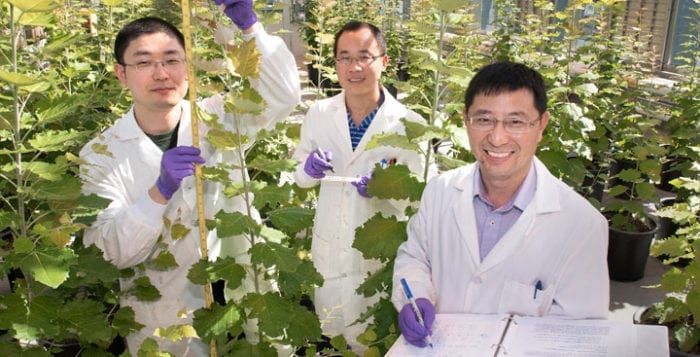
By Daniel Dunaief
It provides structural support, allowing gravity-defying growth toward the sky. While it offers necessary strength, it also makes it more difficult to get inside to convert plant biomass into fuel.
Lignin is the major component that makes cell walls harder. Plants can tolerate the loss of lignin, but dramatically reducing it or altering its structure could severely affect its growth, which makes any effort to modify lignin challenging.
Seeking to balance between the plant’s structural needs and the desire to gain access to biofuel, Chang-Jun Liu, a plant biochemist at Brookhaven National Laboratory, added a step in the synthesis of lignin. “Most studies in this field rely on knocking down or knocking out one or two biosynthetic pathway genes,” said Liu. “We added one more reaction” that competes for the precursors of lignin formation. Liu said he and his collaborators figured that adding that last step in the production of lignin, which is a natural part of plant cell walls, would have the least effect on plant growth while it can effectively reduce lignin content or change its structure.
Liu said he redirected the metabolic precursor by using a modified enzyme he created over the course of several years. The enzyme diverts biosynthetic precursors away from making lignin. Plants typically have three types of lignin, called S, G and H lignin. In a wild-type aspen tree, the ratio of S to G is two to one. This change, however, altered that, turning the ratio to one to two. The general perception is that increasing G lignin would make the cell wall structure stronger and harder, making it harder to release simple sugars. The surprising finding, however, was that reducing S and maintaining G greatly enhanced the release of sugar with digestive enzymes from aspen cell walls.
Scientific partners including John Ralph at the University of Wisconsin and the Great Lakes Bioenergy Research Center confirmed the alteration of lignin structure. Liu tested his enzyme in his earlier work on the flowering plant Arabidopsis. When it worked, he moved on to aspen trees, which grow rapidly and can thrive in environments where typical farm crops struggle to grow. The aspen experiments proved more fruitful in part because these trees contained more S lignin, and the enzyme he developed preferentially blocked the S lignin. The aspen trees with the modified enzyme can yield up to 49 percent more ethanol during fermentation, compared to controls.
Using infrared light at the National Synchrotron Light Source, Liu and his collaborators were able to see an increase in the production of cellulose fibers, which are a primary source of sugars in the cell wall. This may contribute to the release of simple sugars. Liu will continue to explore other possibilities. Other lignin researchers applauded these results.
Liu’s “approach will definitely have a great impact on the cost reduction of cellulosic biofuels,” Dominique Loque, the director of Cell Wall Engineering at the Joint BioEnergy Institute, Lawrence Berkeley National Laboratory, explained in an email. “With no impact on biomass yield and a reduction in recalcitrance, it will reduce the conversion costs of biomass to fermentable sugars.”
While this research, which was recently published in Nature Communications, shows potential commercial promise, Liu and his team are working to answer basic questions. He is interested in further testing his approach in grasses and different trees to determine the effects on lignin content, structure, cell wall digestibility and plant growth. The trees in this experiment were grown in a greenhouse, where scientists could control light and temperature and mimic the natural environment without natural stressors, like insects or fungus. Loque suggested that Liu’s approach can be “easily and quickly optimized to alleviate potential issues such as susceptibility to pathogens” if they exist.
Liu has planted 150 of these altered trees in the field. So far, he said, the biomass yield is not compromised with these experimental plants. “Field tests will allow evaluating the impact of engineering on predators, pathogens and other stresses,” Loque said. Liu was able to create this enzyme after developing an understanding of enzyme structures using x-rays at the NSLS. In that research, Liu was able to gain a better knowledge of how the enzymes that occur naturally worked. Once he knew the structure and method of operation of the enzymes in the lignin pathway, he could make changes that would alter the balance of the different types of lignin.
Liu lives with his wife Yang Chen, a teacher’s assistant in Rocky Point Middle School and their two children, 16-year-old Allen and 14-year-old Bryant. For the last few years, Liu and his family have added hiking, table tennis and tennis to their recreational repertoire.
Liu is encouraged by these findings and is extending and expanding his studies and collaborations. He will work with a Department of Energy sponsored Energy Frontier Research Center. He will also pursue more applied studies to explore the more efficient use of cell wall biomass to produce biomaterials or bio-based products. He is forming a collaboration with Stony Brook’s material science team and with the NSLS-II. “Plant cell wall represents the most abundant biomass on Earth,” Liu said. “Understanding its synthesis, structural property and efficient way in its utilization are critical for our future bio-based economy.”
By Ellen Barcel
When botanists speak of flowering plants, many people think of really showy plants such as rhodies or Kwanzan cherries or Montauk daisies. But most of the plants we commonly grow are all flowering plants; it is just the flowers are really tiny, sometimes so tiny we hardly notice them — really inconspicuous. Nonflowering plants include ferns (reproduce by spores), conifers (cones) and moss (spores).
Oak trees
Like many flowering plants, the oak has separate male and female flowers on the same plant. Note that this is true of squash. Some flowering plants, like holly and gingko, have male flowers on one plant and female on another. To get those beautiful red berries on holly, you must have at least one male plant in the area. And, some flowering plants have male and female organs in the same flower, like tomatoes. Now, back to the oak tree. There are hundreds of species of oak trees. The long-lived tree is a symbol of strength.
In 2004, the oak was adopted as America’s national tree following a vote hosted by the Arbor Day Foundation. Oak trees do extremely well in Long Island’s acidic soil so grow here natively. Oak trees produce male flowers known as catkins, a string of tiny flowers hanging off the branches, before the leaves appear, usually in April. People allergic to oak pollen soon begin to have symptoms. The female flowers, which are incredibly tiny, come out after that. They are so small, notes the University of Tennessee Extension Service that they “require a magnifying glass for identification.” Then, the fruit of the flowers, that is the acorns, form developing over the summer and falling to the ground in fall. Very few acorns survive to sprout since they serve as food for wildlife. Unprocessed, acorns are rich in tannic acid and are not edible by humans. They can be processed and made edible, however. I once had acorn cookies, made by an expert. To my taste, they were dry and not very tasty, but definitely edible.
Dogwood
Looking at dogwood, the white (or pink) flowers we see are actually not flowers but modified leaves known as bracts. The flowers are the really tiny yellow centers. This is also true of poinsettias. The showy red petals are not petals at all but modified leaves. A hint, when selecting poinsettias, look for ones with the yellow centers (the flowers) still tightly closed. Ones that are open and spreading pollen are more mature and won’t last as long in the house.
Boxwood
Another plant that has really tiny flowers is the boxwood (Buxus sempervirens) hedge. The cold hardy, evergreen varieties are native to Europe.
According to the American Boxwood Society, the first planting of boxwood in the Americas was on Long Island’s own Shelter Island at Sylvester Manor in 1653. Boxwood plants are usually used as hedge plants due to how easily they can be pruned to keep them at a given size. Without pruning they can easily reach 15 or more feet. Because boxwood are usually pruned to a given height or shape, we rarely see the flowers that develop in June. Boxwood are so easy to prune, that very overgrown and woody hedges can be cut back almost to the ground, usually a foot or so, and they will grow and fill in nicely, rejuvenating them. The society notes that they do best in a soil pH that is only mildly acidic (6.5 to 7.2) through neutral to mildly alkaline. Despite this, it’s been my observation that boxwood planted near me do extremely well in any soil pH.
Although boxwood can be propagated from stem cuttings, I’ve had a number seed themselves on my property despite the fact that I’ve planted none. For more information on boxwood, go to The American Boxwood Society at www.boxwoodsociety.org. Many other trees and shrubs have very inconspicuous flowers including that of the maple (which sheds its seed pods, the “helicopters” or “whirlybirds” that seem to be everywhere) and mulberry. A really strange flower is that of the fig tree — the figs actually form around the flower so you virtually never see the flower itself. How’s that for tiny?
Next week, not only inconspicuous but unwanted flowers on common plants will be the topic.
Ellen Barcel is a freelance writer and master gardener. Send your gardening questions to [email protected]. To reach Cornell Cooperative Extension and its Master Gardener program, call 631-727-7850.
When Pete Murphy was 12 in the 1970s he could often be found plying the waters of Port Jefferson, exploring and fishing in a 12-foot aluminum boat with a small outboard motor. Today, he’s Captain Pete Murphy, and for the past 20 years he’s been running Sea Tow Port Jefferson, helping old and new friends stay safe on the popular recreational waters of Long Island Sound.
Now 50, Murphy is perfectly at home on these busy waters. After graduating from Ward Melville High School in 1983, he joined the Navy and served as a Boatswain’s mate until he was honorably discharged in 1987. Boatswain’s mates are masters of seamanship, and the training helped Murphy in his career.
“In the Navy I learned how to drive a small boat, how to maintain boats and also did a lot of maintenance on the ships,” Murphy said. “When I got out I worked for three companies on Long Island. We built docks and one company had a small barge with a crane on it that we pushed around from job to job.”
In 1996 Murphy discovered the opportunity that changed his life: He purchased the Sea Tow Port Jefferson franchise from the original owner, Capt. Joe Frohnhoefer, who founded the franchise in 1991. “Sea Tow was right in the realm of what I was doing, and it was on the harbor where I grew up boating,” he said. “It just made sense. I took over the franchise on July 3, 1996, the day before the July Fourth weekend.”
Murphy started with two boats, no staff and only 36 members in his Area of Responsibility, which extends along 25 miles of coastline from the Nissequogue River in Kings Park east to Wading River, and halfway across Long Island Sound. He also serves Smithtown Bay, Port Jefferson and Mount Sinai. “For the first two years I did everything by myself,” Murphy said. “It was slow growth. Now we have thousands of members, and I have expanded the fleet and the staff.” These days his fleet includes three boats, all in the water in Port Jefferson: a 26-foot Boston Whaler with twin outboards and two 24-foot inboard-powered Privateers. Murphy has one full-time captain and two-part-time captains.
He has started another business, Murphy’s Marine Service, to install the temporary moorings for Port Jefferson each spring and take them out in the fall. In addition, he runs a taxi service for boat owners to their boats on the mooring balls. “It definitely keeps me busy,” said Murphy, who has a 100-ton U.S. Coast Guard master’s license, which he recertifies every five years through on-going training. “The mooring and the taxi service are a perfect complement to Sea Tow.”
Murphy and his wife of 15 years, Melissa, have five children: Abigail, 16; Matthew, 14; Peter, 12; Lilah Grace, 7; and Liam, 5. “We have a 24-foot Four Winns, and we love to go boating,” he said. “The fishing is great in the Sound for fluke, bluefish and striped bass. It’s a great family activity to get out in the boat, and the kids love it.” The Long Island Sound has a 7-foot tidal swing, but Murphy’s Area of Responsibility is relatively clear of rocky areas or sand bars.
“When I first started the business I had to charge most people for what I did, because they weren’t members,” Murphy said. “Back then people saw me at boat shows and didn’t like me much. Twenty years later they love Sea Tow. It’s a big change in perception, and a credit to Sea Tow and the value it brings to people.”
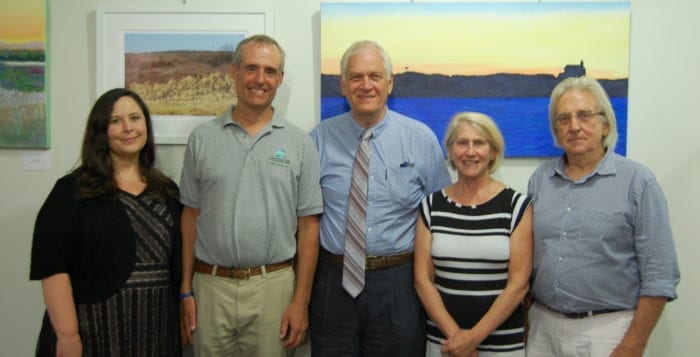
By Heidi Sutton
The Port Jefferson Village Center hosted an artist reception for its latest exhibit, The Natural Beauty of Plum Island, last Thursday evening. The show, which runs through Aug. 30, features photographs by Robert Lorenz and paintings by John H. Sargent, who were granted access to the island over the course of two years.
The paintings and photographs on the second floor of the center quickly draw you in with scenes of beautiful rocky beaches and flower meadows, sunsets with unobstructed views — visions of an island pristine and untouched. One quickly realizes that Plum Island is a local treasure. It is also in peril.
The island has been put up for auction to the highest bidder by the federal government. Operated by the Department of Homeland Security, it is the site of the former U.S. military installation Fort Terry (c. 1897) and the historic Plum Island Lighthouse (c. 1869), which went dark in 1978. It is most known, however, for housing the Plum Island Animal Disease Center, established by the U.S. Department of Agriculture in 1954. The center is relocating to Manhattan, Kansas, and the sale of the island (estimated at $60 million) will help defray the cost of the new facility.
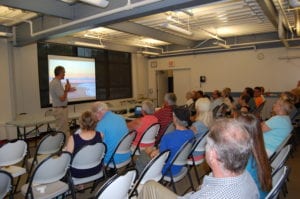
Activists from all over the country have joined forces to try to protect the natural and cultural resources of Plum Island from development by coming up with conservation options and have been holding public forums to keep the community in the loop. So it was only natural to hold one of those forums Thursday, in conjunction with the art exhibit.
The evening started off with a visual presentation titled Preserving Plum Island for Future Generations by Save the Sound’s Special Projects Coordinator Chris Cryder. Save the Sound is a bi-state program with the Connecticut Fund for the Environment and has been locked in a legal battle with the government to save the island since 2009. Cryder is also the outreach coordinator for the Preserve Plum Island Coalition.
Located off the tip of the North Fork of Long Island in the town boundaries of Southold, where the Long Island Sound and Peconic Bay meet, Plum Island is part of an archipelago of peninsulas and islands that includes Great Gull Island, Little Gull Island, Fisher’s Island and Rhode Island. The land was “formed 22,000 years ago when the last glacier was here … and deposited its boulders and glacier materials,” explained Cryder, noting that the area contains a very rich marine life.
The 843-acre coastal island, which is about three miles long, has not had much human disturbance since World War II, according to Cryder. “At one time, this island was completely denuded, but 80 percent of the island — over 600 acres — has been allowed to return to its natural state and … has become home to some of our most imperiled species,” he said. “It’s a really special place. You feel like you’re in a whole other world.”
According to Cryder, there are over 16 rare plants on the island, six of which are endangered, including Spring Ladies’ Tresses. The island, which features nine miles of beach, forests, marshes, dunes, flower meadows and over 100 acres of interior wetlands, is also home to over 220 bird species, including the endangered piping plover and the rare roseate tern. Large colonies of grey seals and harbor seals, the northern right whale and leatherback sea turtles congregate in the area. “We feel it is a one-of-a-kind island, probably the most important coastal habitat on the whole eastern seaboard right now,” added Cryder.
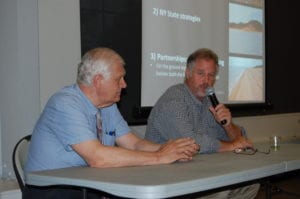
A panel discussion, which included naturalist John Turner, spokesperson for the Preserve Plum Island Coalition, and Assemblyman Steve Englebright (D-Setauket) followed the presentation. Moderated by Leah Schmalz, program manager for Save the Sound, both panelists spoke on the importance of saving this jewel from development and discussed the current status of legislation pending in Congress.
“I’ve been fascinated with Plum Island, mostly from a distance, for years,” said Englebright, who visited the island for the first time this spring, with Senator Ken LaValle (R-Port Jefferson) and the Supervisor of Southhold. “I was very impressed; I felt like I was in a movie,” he said, describing seeing basking seals and the many bird species. “From my perspective, I would love to see Plum Island become a part of Orient State Park. It would be a spectacularly popular site for naturalists and families and groups of all kinds to visit.”
“We ultimately have no doubt that we will prevail in stopping the sale of Plum Island,” said Turner, “because the island sells itself … in terms of historical significance, the cultural significance, ecological and environmental significance. There are very few places like Plum Island anywhere and it’s in the public domain and it should stay in the public domain.”
“…most people go by on the [Cross Sound] Ferry and see the island and have no idea what’s happening and every time we talk to a group like this we find people saying ‘how is it that the federal government is really thinking about selling this?’” said Schmalz. “One of the ways to get involved is to sign a petition [by visiting www.savethesound.org]. It’s a very easy way to put your name on record saying you want this island to be preserved.”

By Rebecca Anzel
The Town of Brookhaven will start construction next month on Shore Road between Mount Sinai-Coram Road and Rocky Hill Road in an effort to alleviate the negative impact of stormwater runoff in Mount Sinai Harbor.
“This is one project I identified really early on when I took this office three years ago,” Brookhaven Town Highway Superintendent Daniel Losquadro (R) said. “I think if you’re a resident of Long Island, or this case specifically, the North Shore, you understand this is a very serious problem to our quality of life, our recreation opportunities and our health.”
Brookhaven is installing a series of 10 leaching pools along the road to capture stormwater before it reaches the harbor.
Paid for by a New York State Department of Transportation grant worth $382,560, the project will take almost three months to complete.
Losquadro became highway superintendent right after Hurricane Irene in August 2011 and before Superstorm Sandy in late October the following year. There was a lot of damage to the coast from both storms, he said, and none of the repair work had been done by the time he took office.
Currently, a lot of stormwater runoff is flowing into the harbor from the roads and rooftops in the area, bringing with it chemicals, sediment, debris and other pollutants. This is an issue plaguing 75 percent of impaired bodies of water in New York State, according to the Department of Environmental Conservation’s website.
To fix the problem, the town is installing a series of 10 leaching pools along the road to capture as much stormwater into the ground as possible before it reaches the harbor. Water enters these catch basins and percolates into the ground gradually, filtered through a natural process. Each one has a capacity of more than 3,000 gallons.
Two bioretention areas will also be installed to naturally filter out any toxins from the water that does make it to the harbor, much in the way wetlands do. An existing discharge pipe will be removed.
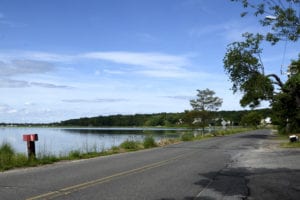
Losquadro said residents have asked if a concrete breakwater put along the edge of the harbor some years ago will be removed as part of this project. Because the harbor’s ecosystem has reestablished itself around that concrete, the DEC does not want it removed.
“I have to say it was kind of surprising to me, but I understand the DEC’s point,” Losquadro said. “They feel it would be more injurious to the environment to dig that out and replace it than to just leave it as it is.”
The town will also be resurfacing nine roads in the area, which Losquadro said are in “deplorable condition,” this fall. The cost, about $900,000, is not covered by the state grant.
Mount Sinai resident Julie Bernatzky walks along Shore Road often.
Although the project is starting a year later than planned, as a result of a delay following a change in the region’s DEC director Losquadro said, Bernatzky is happy for the upgrades, although she hopes the construction will not disrupt her route.
Losquadro said traffic in the area should not be any more disrupted than during any other project. Because the area the town will be working in is tight and there is not a lot of room on the side of the road, one lane of Shore Road may need to be closed.
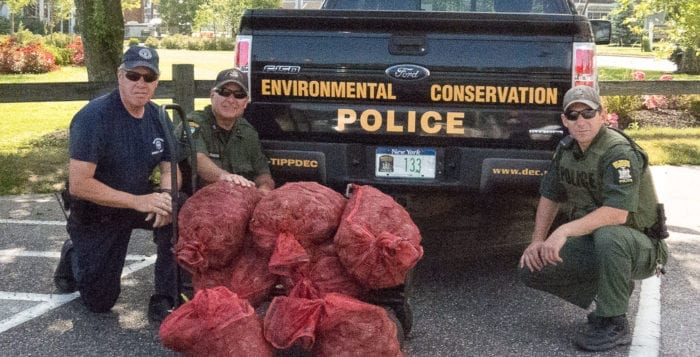
The world is not your oyster.
Brookhaven Town and the New York State Department of Environmental Conservation thwarted offenders on Friday who they said, in two unrelated incidents on June 30 and July 3, illegally harvested oysters from the Long Island Sound near Flax Pond in Old Field and Mount Sinai Harbor respectively. Between the two incidents nearly 2,000 oysters were seized and returned to their habitats.
On June 30 Brookhaven Harbormaster stationed in Port Jefferson Harbor received a tip that oysters smaller in size than three inches — which is below the allowable size for harvest — were being taken from the Sound. Following an inspection by DEC officials, violations were issued to the oystermen and the animals were returned to the water.
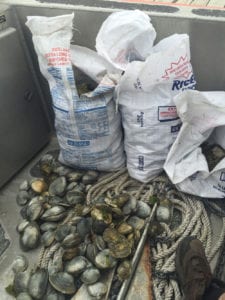
“I applaud the actions of our Harbormasters and the DEC,” Brookhaven Councilwoman Valerie Cartright (D-Port Jefferson Station), whose district includes Port Jefferson Harbor said in a statement Friday. “Shellfish are vital to our harbor, providing a natural means of removing harmful nitrogen from our waters. I urge residents to both respect harvesting laws and to get involved in our local mariculture programs that help cultivate the shellfish populations in our harbors and bays.”
On July 3 four people harvested oysters from illegal areas of Mount Sinai Harbor, according to the town. Brookhaven Town Bay constables witnessed the violation, seized the oysters and returned them to the harbor.
Mount Sinai Harbor falls within Councilwoman Jane Bonner’s (C-Rocky Point) district.
“It is very disappointing when people break the law without any concern for its effect on the environment,” Bonner said in a statement. “For many years, shellfish were over harvested and we are now working hard to increase their population. I urge anyone who knows of illegal shell fishing to report it to the Town or DEC.”
The statement from the town stressed the importance of protecting shellfish in Long Island waters.
“Increasing the number of oysters and other shellfish in our waterways helps to reduce the abundance of algae that can lead to fish kills and diminished oxygen concentration and thus improve water quality,” town officials said. “Oysters feed on floating microscopic algae by filtering them out of the overlying water. One adult oyster can filter up to 50 gallons of water a day.”
By Katelyn Winter
Peaceful. The word most commonly used to describe Setauket’s Frank Melville Memorial Park captures the tranquil nature scene you find around every bend in the trail.
With turtles sunning themselves on logs in the daytime and deer rustling in the brush just before dusk, the park is a sanctuary for wildlife. According to the park’s newsletter, the Four Harbors Audubon Society, which holds a bird walk at the park on the second Saturday of every month, recorded 76 bird species over the past year. One of the main reasons so many creatures can be seen is simply the atmosphere. On the sign at the entryway to the park, the informative bullet points end in a gentle reminder: Quiet please.
Frank Melville Memorial Park’s gates have been open to the public for 79 years. In 1937, the park was formally dedicated after years of work by Jennie MacConnell Melville and local philanthropist Ward Melville, the wife and son of Frank Melville. The park was added to the National Register of Historic Places on July 19, 2010.
The Melville family loved to spend their summers in the Stony Brook area and even had an estate, named Sunwood, built in Old Field in 1919. It is fitting that the place they designed and built to memorialize a loving father and husband would turn into such a picturesque and beloved park by Three Village residents and visitors alike.
“I’ve been coming here for almost ten years. It’s only her second year, though,” said Kaleigh Gorman, motioning to her dog, Dakota, when they were out walking one warm Wednesday evening. “I love how peaceful and scenic the park is and all the memories that are made here.”
There is definitely a lot of room to make memories. With 24 stunning acres to explore, the park is made up of a looping path around the pond and trails that wind through the bamboo forest and the meadows behind the Bates Barn, known locally as “the red barn.” Constructed in the 1920s, the wood for the barn came from buildings at Camp Upton near Yaphank, which was torn down after WWI. A community garden with its own apiary and the Bates House, which can be rented for private events, are just some of the park’s other charming features.
Frank Melville Memorial Park
Hours:
Open all year round from dawn to dusk
Address:
1 Old Field Road, Setauket
Phone number:
Park Office: 631-689-6146
Bates House: 631-689-7054
Website:
www.frankmelvillepark.org
Rules:
No professional photography without park pass
Dogs allowed on leash
Visitors can go for a jog around the pond, stopping to stretch out on the stone bridge with a view of both the pond and the marshlands, or sit on one of several benches that line the edge of the pond under large shade trees. Just to the side of that bridge is the Setauket Mill, a simulated mill with a working water wheel. Built in 1937, it was designed by architect Richard Haviland Smythe, who also designed the Stony Brook Village Center, to represent the long line of mills that had existed on the pond as early as 1660. The building now serves as the park’s headquarters.
You should feel free to bring in snacks for a picnic, but keep in mind to carry out what you carry in, and never feed the wildlife. And watch out! That wildlife also includes a snapping turtle who will snap at anything that moves too close to his algae-covered face. He’s been around for ages. When I was just five years old, I thought I was looking at an otter emerging from the pond, until my mother realized it was the snapping turtle reaching out his long neck for a snack. The snapping turtle is by no means dangerous, though: just one more fun local “resident” to encounter. In fact, local resident Janet Morseman says that one of the reasons she loves coming to the Setauket park is because of how “safe and peaceful” it is.
Whether you are out for a brisk walk, a jog or a leisurely stroll, the ground beneath your feet is always clean, and the park, which is located next to the post office and just a short walk from Patriot’s Rock and Emma S. Clark Memorial Library, is small and well-enough trafficked to feel very safe.
The rules and regulations of Frank Melville Memorial Park, a “Private Park for Public Enjoyment,” are fairly lax and rely on common courtesy. If you’d like to ride your bike there, for example, it’s requested you stay on the paved pathway. Fishing in the pond requires you to join the Mill Pond Fishing Club, with a catch-and-release only policy.
And as far as photography in the park goes, anything more than snapping a picture of your kids with a cell phone (say, having a friend take your family holiday card photo at the park) means signing up to become a Friend of the Park and getting a photography pass. It will cost you $100 annually to be able to shoot photos in the park.
Those aren’t the only ways to take advantage of Frank Melville Memorial Park, though — it has so much to offer. Classes on Tuesday mornings at the Bates Barn — usually at 11 a.m. — are free ways to learn new skills, such as watercolor painting or have fun with a craft or scavenger hunt. One new opportunity is Walk-Yoga-Meditate-Chocolate, which is exactly what it sounds like. At 7 p.m. on Tuesday evenings through August 30, pre-registered participants will meet up in the Bates House parking lot to take a walk, practice yoga, mediate, and indulge in some chocolate. The class, by suggested donation, benefits the Community Growth Center. To learn more or register you can visit www.CommunityGrowthCenter.org or call 631-240-3471.
For those who are looking for a different way to relax, check out Wind Down Sundays, the park’s summer concert series held at the Bates Barn on Sunday evenings at 5:15 p.m. through Aug. 28. A variety of musicians will play classical, rock, jazz, reggae, R&B, and pop, which means there’s at least one Sunday you won’t want to miss, depending on your taste! These events are family-friendly ways to get outside and experience something new in a beautiful location.
So pack up the kids, or the dog, or just a water bottle, and see what Frank Melville Memorial Park has in store for you. You may discover a favorite jogging trail, the perfect bench for reading, or the cutest baby turtle you’ve ever seen. There’s so much to do and see, no matter the time of day. And that’s why Frank Melville Memorial Park is a treasure among us.
Author Katelyn Winter is a rising junior at Muhlenberg College in Allentown, Pa., majoring in English and creative writing. She is from Stony Brook and hopes to one day work in the publishing industry.
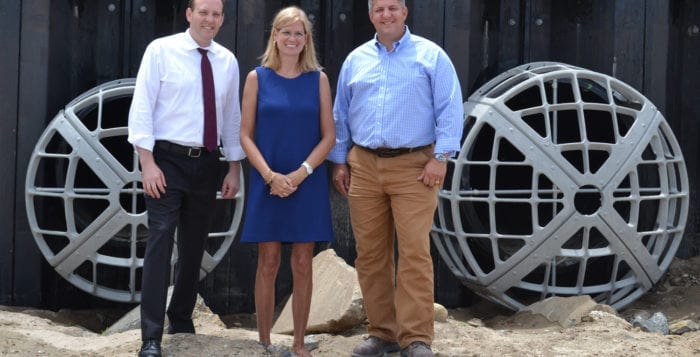
Brookhaven Town Highway Superintendent Dan Losquadro (R), U.S. Rep. Lee Zeldin (R-Shirley) and Councilwoman Jane Bonner (C-Rocky Point) announced the completion of repairs intended to protect, restore and strengthen Sills Gully Beach in Shoreham, after it was severely damaged during Superstorm Sandy in 2012.
“The revitalization project at Sills Gully is one of a dozen North Shore surface water quality protection projects the highway department has undertaken since I took office,” Losquadro said. “I want to thank Congressman Zeldin for expediting the federal funding necessary to complete this project and ensure the resilience of our shoreline.”
“Preventing storm water runoff from entering the Long Island Sound this is a victory for the residents of Shoreham and the environment.”
— Jane Bonner
In order to reduce risk of damage from future storm events, members of the Brookhaven highway department completely removed the ineffective gabion basket walls, replacing them with 160 feet of steel bulkhead with stone-toe protection to prevent scouring. The bulkhead — which now protects areas of the bluff that have experienced significant levels of erosion in the past — has a longer life span than the gabion walls and will better protect from future disasters.
“The completion of restoration at Sills Gully Beach is an excellent example of different levels of government working together for the benefit of our community,” Bonner said. “I have been diligently working on this issue since the damage was caused by Superstorm Sandy in 2012, and I am extremely happy to see these necessary repairs come to fruition. By preventing storm water runoff from entering the Long Island Sound, this is a victory for the residents of Shoreham and the environment. I want to thank Congressman Zeldin and Superintendent Losquadro for working with me to make this happen.”
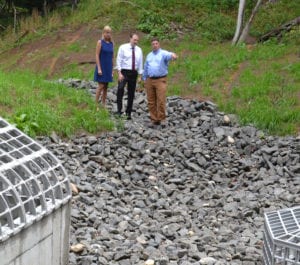
As a result of these mitigation measures and to comply with Tidal Wetlands and Clean Water Act permits, the department included upgrades to the existing storm water system by installing a new bioretention area where storm water naturally collects. This bioretention area consists of two, 12-foot deep leaching basins and an 8-foot wide trash rack to capture storm water and transport it through nearly 400 feet of 48-inch, smooth, interior-corrugated polyethylene pipe for natural dissipation. Additionally, a rock-lined drainage swale was constructed along the length of the parking lot to collect any remaining runoff. These upgrades will ensure that polluted storm water is not directly entering the Long Island Sound.
The project was funded with an $875,000 federal grant secured by Zeldin through FEMA.
“Once Brookhaven Town received the necessary federal funding to make repairs at Sills Gully Beach and Gully Landing Drainage Facility, the town was able to complete this important project,” said Zeldin, who is also a member of the House Transportation and Infrastructure Committee. “This revitalization project will help protect, restore and strengthen Sills Gully Beach in Shoreham and the overall quality of water in our local area, and I am proud to join with Superintendent Losquadro and Councilwoman Bonner to announce the completion of this project.”
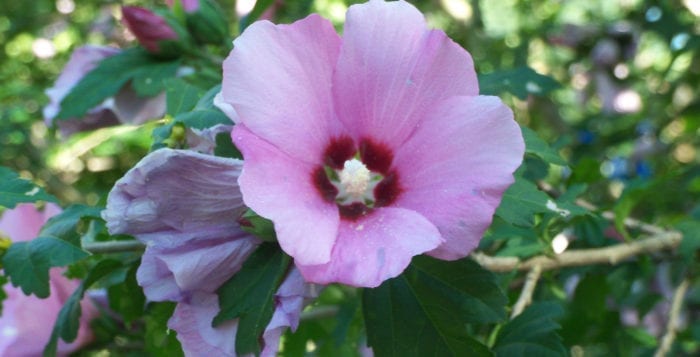
By Ellen Barcel
Many times a plant appears in the garden that the gardener didn’t plant. A weed? Perhaps, but it really helps to know what seedlings and young plants look like so that you can see if a “volunteer” is a prize or a pain.
Among the not-really-wanted plants that easily volunteer in the garden include dandelions, onion grass, garlic mustard, wineberries, multiflora roses and oriental bittersweet. While onion grass is a mild nuisance, just mow over it, garlic mustard easily grows to a foot or more in height and is really unsightly.
Wineberries are an invasive plant, related to raspberries, that can be spread by birds. The berries are definitely edible, but not nearly as tasty as raspberries. If you want raspberries, then plant them and pull out the wineberries — carefully because they have thorns.
Multiflora roses are attractive, with many (hence the term multiflora) blooms in early June borne on arching canes. Years ago, they were planted by many Long Island gardeners because of their rapid growth and dense habit. They were even sold as a living fence for cattle. But, and here’s the big but, they are extremely invasive. Like wineberries, be careful pulling them out because of the thorns.
Another volunteer that is extremely invasive is oriental bittersweet. It’s very pretty with its red berries that break open to reveal yellow seeds, but it’s definitely invasive. Lesser celandine has pretty yellow flowers in the spring but, again, is very invasive.
Note that wineberries, multiflora roses and oriental bittersweet as well as lesser celandine are all on Suffolk County’s Do Not Sell List. However, there are so many here already and they are so easily spread, especially by birds, that it’s still a battle getting rid of these invasives.
On the other hand, there are a number of volunteers that are welcome in the garden. Reseeding plants that you’ve put in the garden are wonderful. They may not be perennials but they’re almost as good. In this category includes the money plant (Lunaria) with its purple flowers and silvery seed pods.
Many years ago, a small tree planted itself in my back yard. Curious as to what it was, I left it alone and it matured into a gorgeous tree covered in pink flowers in the spring. I never did figure out what it was — there were a number of possibilities. It could have been some variety of cherry, but it never bore fruit, so I never did find out. It was a welcome volunteer and sadly missed when one spring, it became obvious that it didn’t make it through the previous harsh winter.
Another volunteer that is most welcome in my garden was also filled with pink flowers. Again, I couldn’t figure out exactly what it was until it started to produce peaches. Unfortunately, the variety were small and bitter, so I don’t use them instead allowing the local critters to dine. But, I don’t take the trees out either, because they produce nice shade and those beautiful flowers.
I’ve had rose of Sharon and holly also seed themselves in the garden, both welcome plants. On the other hand, the thistle that seeded itself by my front door, while interesting, was a danger. Tiny maple trees (Norway maple, Acer platanoides) try to take over my garden — they’re everywhere. Simply cutting them off at ground level with a pruning shears usually works, and small ones can be easily pulled out especially after a rain.
Another beneficial volunteer is clover in the lawn. It’s a nitrogen fixing plant that takes nitrogen from the air and stores it in its roots. It attracts pollinators and is low maintenance. However, many broad- spectrum weed killers will kill it, so read the label carefully of any products you consider using.
When you find any of these volunteers, remove the nasty ones, but allow some of the questionable ones to grow a while and mature so that you can figure out whether you have a bonus in the garden or not. They may provide you with a beautiful tomorrow in your garden.
An excellent book to help you identify some unknown plants and decide whether or not they’re keepers is “Weeds of the North East,” by Richard H. Uva, Joseph C. Neal and Joseph M. DiTomaso. The volume is published by Comstock Publishing, a division of Cornell University Press. It has color photos of the plant, closeups of the leaves, flowers and seeds. It’s a great resource.
Ellen Barcel is a freelance writer and master gardener. Send your gardening questions to [email protected]. To reach Cornell Cooperative Extension and its Master Gardener program, call 631-727-7850.
